When it comes to cutting 20mm porcelain tiles, selecting the right tool is essential to achieving a clean, professional finish while maintaining efficiency on the job. It’s a key part of learning how to tile. Two of the most popular types of electric tile cutters for this task are bridge saws and rail saws, each offering unique advantages and disadvantages. In this blog, we will compare these two types of saws, with a special focus on the RUBI DCX Bridge Saw and the RUBI TC 125 Rail Saw. By examining the features, capabilities, and limitations of both, you can determine which electric tile cutter best suits your needs.

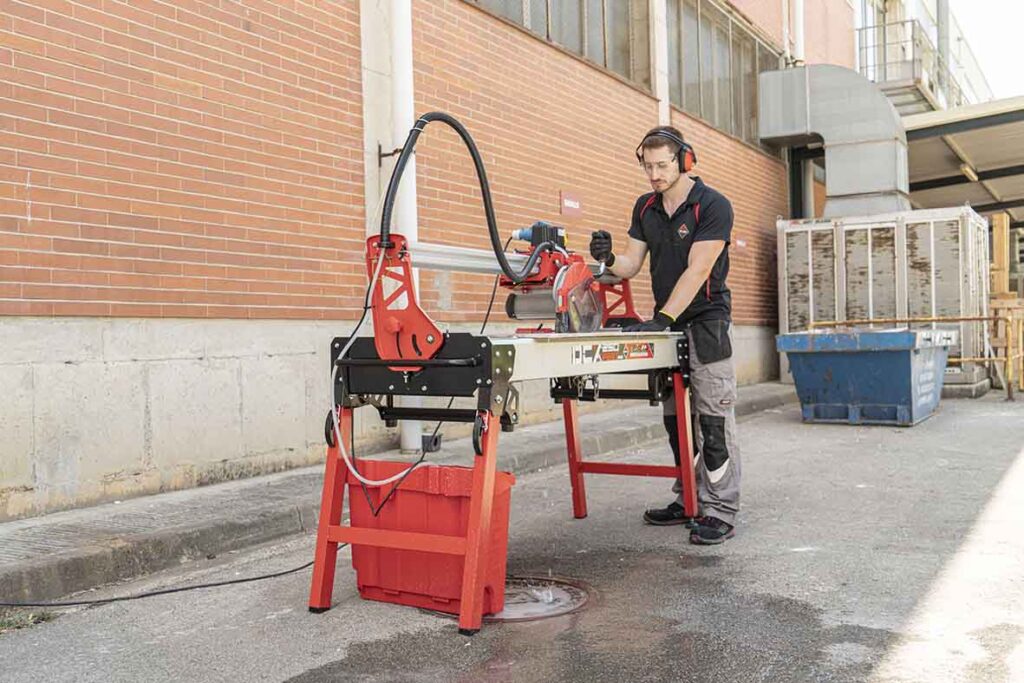
Bridge Saws vs Rail Saws
Before diving into specific models, let’s start with a broad comparison of bridge saws and rail saws. Both are electric tile cutters designed to handle tough materials like 20mm porcelain, but they excel in different areas.
Bridge Saws
Bridge saws are engineered for precision and control, which makes them an excellent choice for executing repetitive cuts. With a stationary cutting head mounted on a rail or bridge, the tile moves beneath the blade, allowing for straight, consistent cuts. These saws are especially well-suited for large production runs that require cutting multiple tiles to the same dimensions.
Pros of Bridge Saws:
- Better for repetitive cuts, making them ideal for batch work.
- Superior control over the cut, which often results in a smoother, more polished finish.
- Bridge saws tend to be more effective at handling mitre cuts, as the cutting head is better stabilized.
- Typically dust-free when equipped with a water-cooling system, which helps manage debris and extends the blade’s life.
Cons of Bridge Saws:
- Bridge saws usually have a size limit, which can be restrictive when working with larger tiles or slabs.
- They are bulkier machines, making them harder to transport and store compared to rail saws.
Rail Saws
Rail saws, on the other hand, are designed for flexibility and portability. The cutting head moves along a rail, allowing for longer cuts, and they are particularly effective for cutting large-format tiles or creating borders and pathways. Rail saws also offer the advantage of being compact and easier to transport, making them a favourite for jobs where mobility is essential.
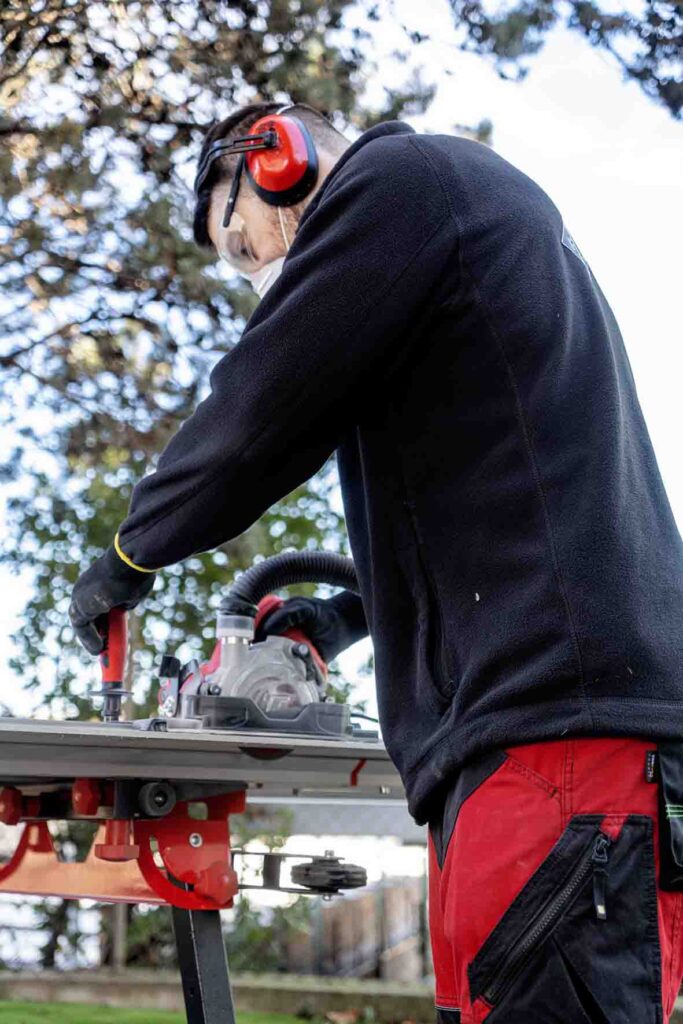
Pros of Rail Saws:
- Excellent for longer cuts and working on large-format tiles or multiple tiles at once.
- Compact, lightweight, and easier to transport and store than bridge saws.
- Lower blade cost due to smaller size, which can reduce operating expenses over time.
- Can be fitted with a dust extraction system to manage debris.
Cons of Rail Saws:
- Setting up a rail saw can be time-consuming, especially for individual cuts, as you need to adjust the setup for each tile.
- They don’t provide the same level of control and precision as a bridge saw, which can affect the quality of the cut, particularly on mitres.

RUBI DCX Bridge Saw vs. RUBI TC 125 G2 Rail Saw
Now, let’s take a closer look at two specific electric tile cutters from RUBI: the DCX Bridge Saw and the TC 125 G2 Rail Saw. Both models are top choices for cutting 20mm porcelain tiles, but they cater to different cutting needs and work environments.
RUBI DCX Bridge Saw
The RUBI DCX is part of RUBI’s professional-grade electric tile cutter range. With its robust design and high-powered motor, the DCX is built to handle large volumes of work with precision and efficiency.
Key Features of the RUBI DCX:
- Repetitive Cuts: The DCX excels in batch production. If you’re cutting multiple tiles to the same size, this bridge saw allows for fast, consistent results with minimal setup between cuts.
- Precision: The DCX bridge saw offers superior control during cuts, which results in a clean, smooth edge. This is especially useful for mitring, as the stabilized head allows for more accurate angled cuts.
- Dust-Free Operation: Equipped with a water-cooling system, the DCX ensures minimal dust production, making it a cleaner option for indoor workspaces.
- Tile Size Limitations: One of the drawbacks of a bridge saw like the DCX is its size restriction. If you’re working with extra-large tiles or slabs, you may find the DCX limiting in terms of maximum cutting length.
The DCX’s motor provides 1.5 HP of power, making it well-suited to cutting thick, dense materials like 20mm porcelain.
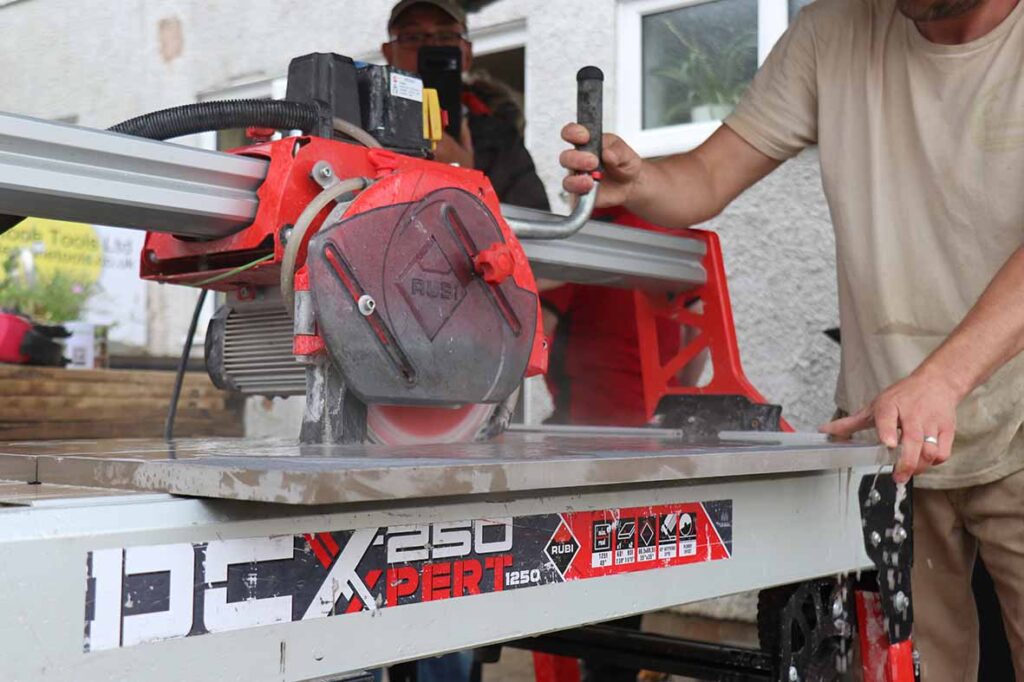
RUBI TC 125 G2 Rail Saw
The RUBI TC 125 G2 is a rail saw designed for flexibility and versatility. Its main advantage lies in its ability to cut large-format tiles, as the cutting head moves along a rail, allowing for longer and more flexible cuts.
Key Features of the RUBI TC 125 G2:
- Long Cuts: The TC 125 is excellent for handling long, straight cuts. It is ideal for creating pathways, borders, or working with extra-large tiles.
- Compact and Portable: Rail saws like the TC 125 are lighter and more compact than bridge saws. They are easier to transport to different job sites. Storage is also simpler due to their smaller footprint.
- Dust Extraction: The TC 125 G2 is not inherently dust-free, but pairing it with a dust extraction system helps manage debris and keep the workspace clean.
- Set-Up Time: A major downside of the TC 125 is that it takes a significant amount of time to set up each cut. Unlike bridge saws, which excel in repetitive tasks, rail saws require individual adjustments for each tile. This can slow down productivity.
The TC 125 G2’s motor has a 1.6 HP rating, offering slightly more power than the DCX. This motor size can be beneficial for cutting harder materials like 20mm porcelain.
Blade Differences and Costs
One area where rail saws like the TC 125 G2 excel is in the cost of blades. Rail saw blades tend to be smaller, which means they are typically less expensive to replace. This can reduce operating costs, especially on larger projects that require multiple blade changes. In contrast, the larger blades used on bridge saws like the DCX tend to be more expensive, but they also distribute heat more evenly, which can prolong blade life when used with water cooling systems.
Both the DCX and TC 125 can handle mitre cuts, but the design of bridge saws like the DCX allows for better control in this process, resulting in a more precise finish.
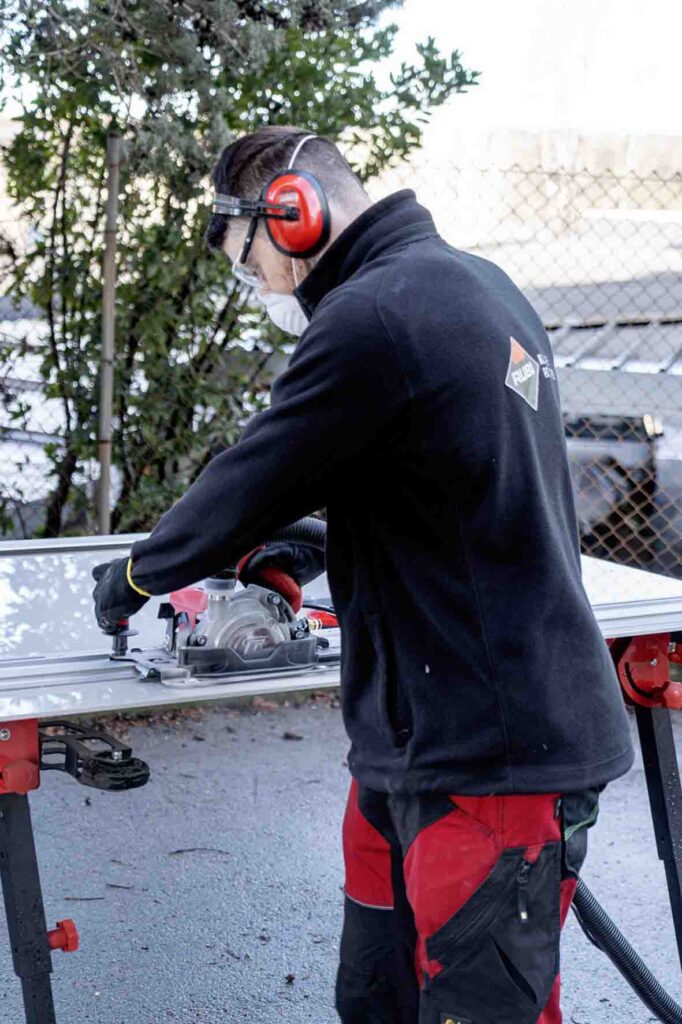
Which is Better for Cutting 20mm Porcelain?
Ultimately, the choice between a bridge saw like the RUBI DCX and a rail saw like the RUBI TC 125 G2 depends on your specific project needs.
- For Repetitive, Precise Cuts: The RUBI DCX is the better choice. It offers more control, a cleaner finish, and dust-free operation, making it ideal for professional tilers working on large batches of tiles.
- For versatility and Large Tiles: If you need to cut long tiles, multiple tiles at once, or work on-site with different tile sizes, the RUBI TC 125 G2 is the better option. Its portability, ease of setup for larger jobs, and lower blade cost make it a versatile tool.
Conclusion
Both the RUBI DCX Bridge Saw and the RUBI TC 125 G2 Rail Saw are exceptional electric tile cutters, each with its own strengths. The DCX provides greater precision and is ideal for repetitive tasks, while the TC 125 G2 excels in flexibility and performing long cuts. Understanding the pros and cons of each will help you select the best tool for cutting 20mm porcelain, ensuring both efficiency and top-quality results.
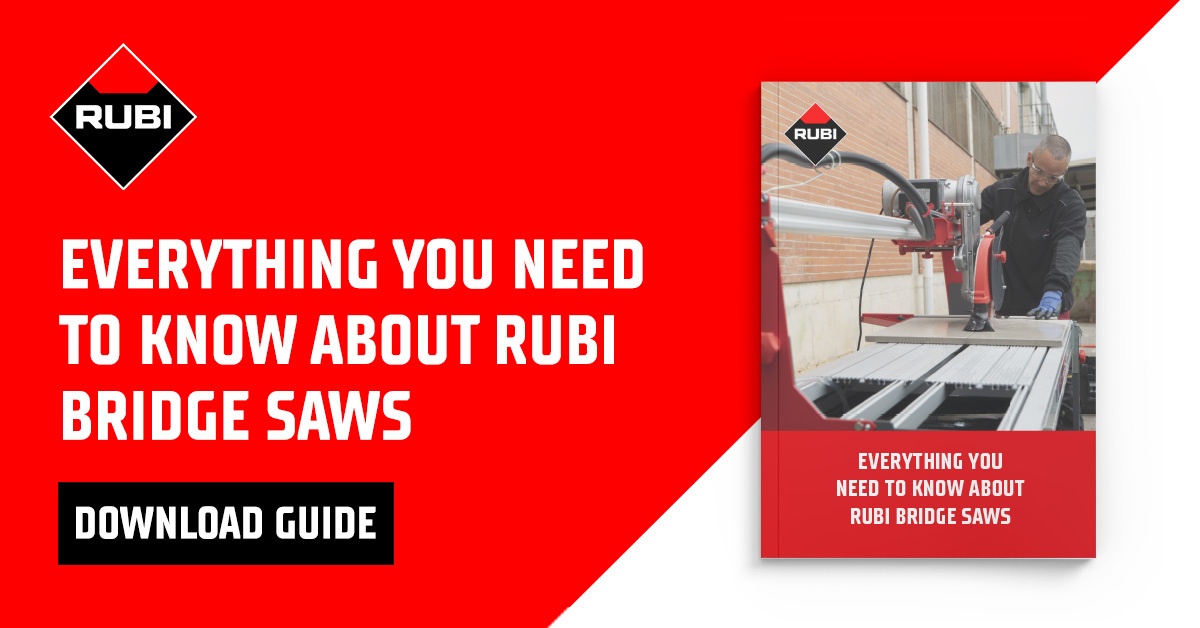

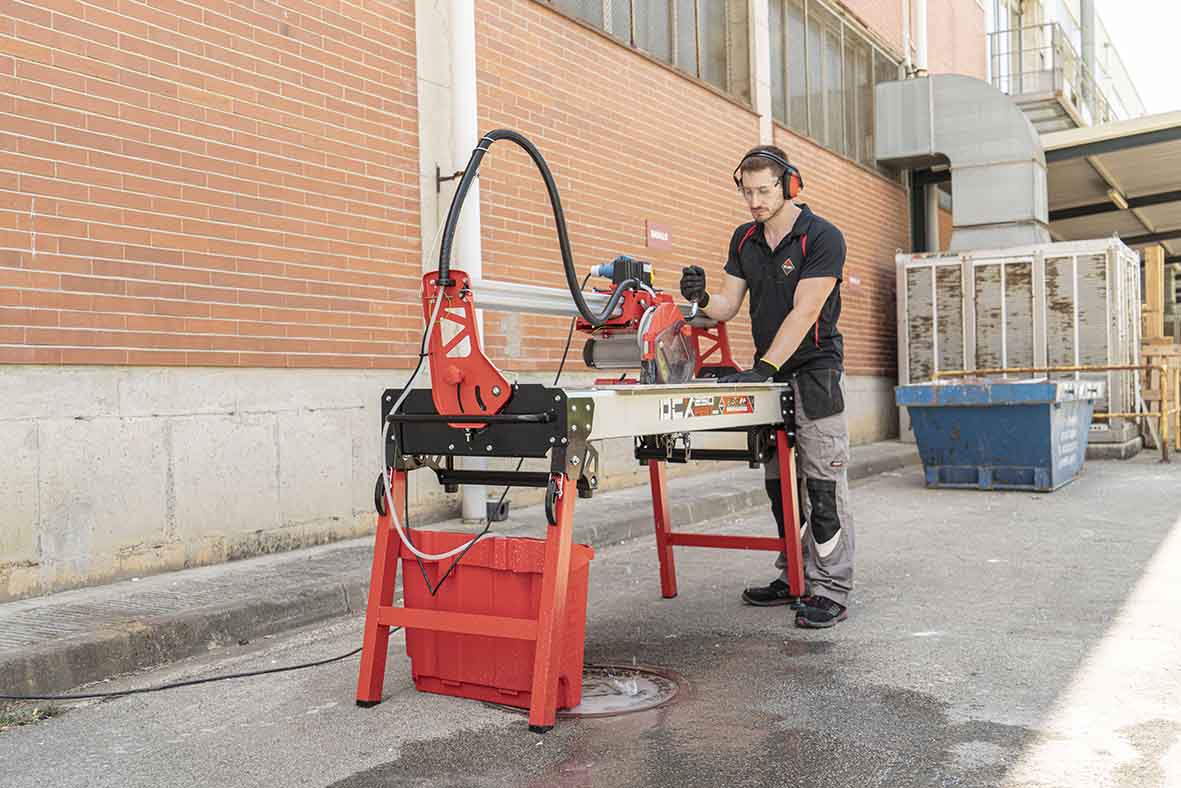
Post a comment